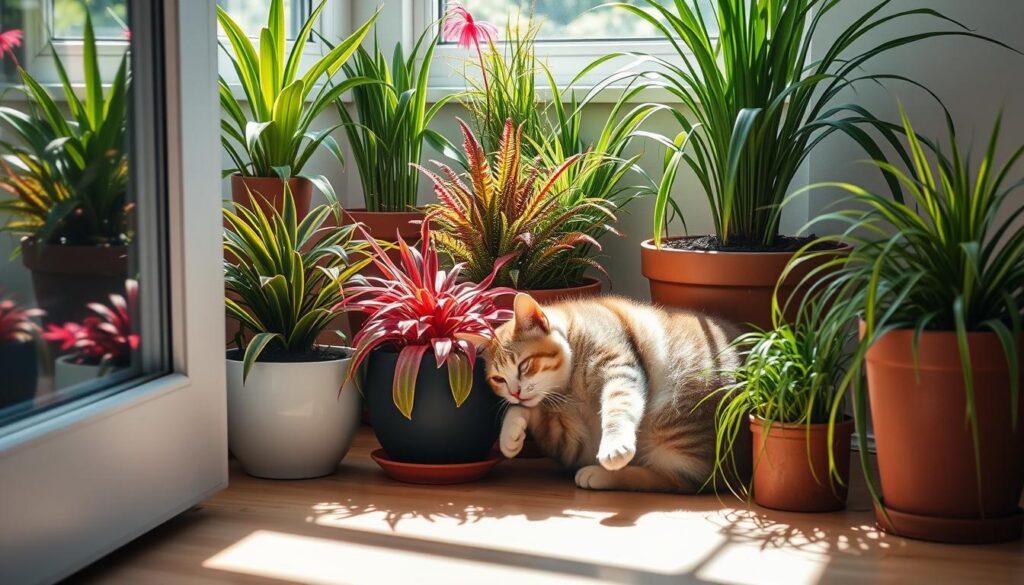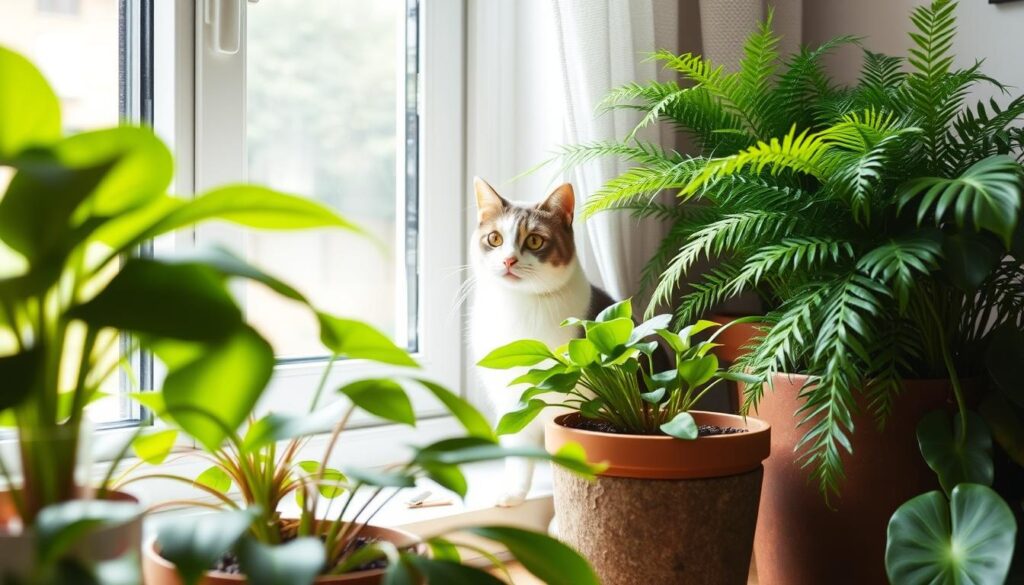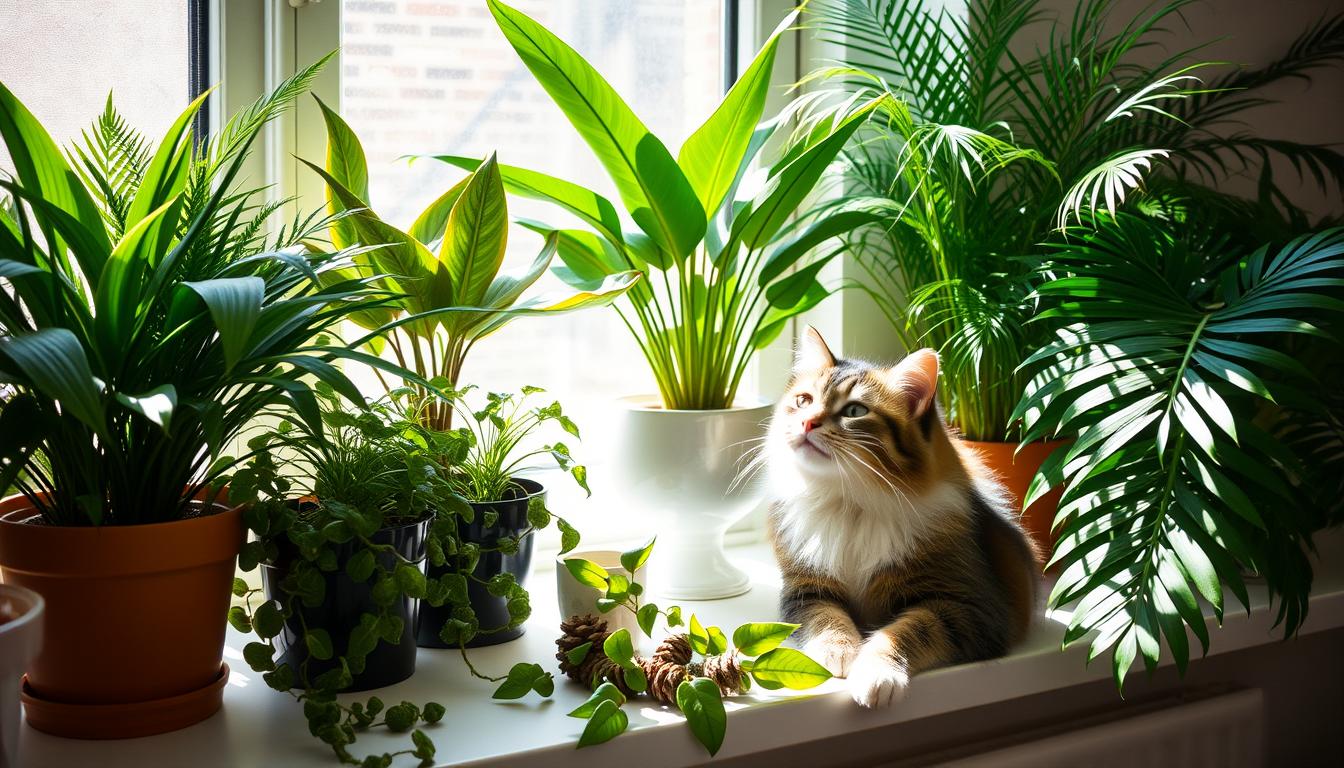What makes a houseplant safe for your cat, and how can you ensure your feline friend doesn’t accidentally ingest a toxic plant? As a responsible cat owner, it’s crucial to choose cat-safe plants, non-toxic plants for cats, and pet-friendly houseplants to create a welcoming environment.
With so many plants to choose from, selecting the right ones can be overwhelming. Cat-safe plants, non-toxic plants for cats, and pet-friendly houseplants are essential for any cat owner looking to bring some greenery into their home. In this article, we’ll explore the world of cat-friendly plants, discussing the importance of selecting non-toxic plants and providing tips for creating a cat-friendly garden with cat-safe plants and pet-friendly houseplants.
Understanding the Importance of Cat-Safe Plants
As a cat owner, it’s essential to be aware of the potential risks associated with indoor plants. Many common houseplants can be toxic to cats, causing a range of symptoms from mild discomfort to life-threatening conditions. To ensure the health and well-being of your feline friends, it’s crucial to choose safe plants for feline friends and create a cat-friendly environment.
Some indoor plants safe for cats include those that are non-toxic and won’t cause harm if ingested. However, it’s still important to take precautions and keep an eye on your cat’s behavior around plants. Cat-proof plants can be a great option, as they are designed to be safe and durable.
To protect your cat from toxic plants, it’s essential to be aware of the common risks and take steps to prevent accidents. This includes keeping toxic plants out of reach, choosing safe plants for feline friends, and being aware of the symptoms of plant poisoning. By taking these precautions, you can create a safe and happy environment for your cat to thrive.
Why Cats and Houseplants Don’t Always Mix
- Cats are naturally curious and may ingest plants out of curiosity or boredom
- Some houseplants can cause severe symptoms, including vomiting, diarrhea, and respiratory problems
- Even non-toxic plants can cause gastrointestinal upset if ingested in large quantities
Common Risks to Cats from Toxic Plants
Some common houseplants that are toxic to cats include lilies, sago palms, and tulips. These plants can cause a range of symptoms, from mild to severe, and can be life-threatening if ingested. By choosing indoor plants safe for cats and taking precautions, you can help protect your cat from these risks and create a safe and happy environment.
Popular Cat-Safe Plants for Your Home
When it comes to choosing plants that are safe for cats, there are many beautiful and non-toxic options to consider. Plants that are safe for cats, such as spider plants and Boston ferns, can add a touch of greenery to your home without posing a risk to your feline friends. Feline-friendly foliage like these plants can help purify the air and create a calming atmosphere, making them a great choice for cat owners.
Some popular cat-safe plants include:
- Spider plants: easy to care for and great for air purification
- Boston ferns: beautiful and non-toxic, making them a great choice for hanging baskets
- Areca palms: a cat-friendly delight that can help remove toxins from the air
These plants that won’t harm cats are not only safe but also easy to care for, making them a great choice for busy pet owners. By choosing plants that are safe for cats, you can create a beautiful and welcoming home for both you and your feline companion. 
A Safe Choice for Your Home
Remember to always double-check the toxicity of any plant before bringing it into your home. With a little research and planning, you can create a beautiful and cat-friendly space that you and your pet can enjoy together.
Identifying Poisonous Plants for Cats
As a cat owner, it’s essential to be aware of the plants that can harm your feline friends. Many common houseplants are toxic to cats, and ingesting them can lead to severe health issues. To keep your cat safe, it’s crucial to identify poisonous plants and take steps to prevent ingestion.
Some common houseplants that are toxic to cats include lilies, sago palms, and snake plants. These plants contain toxic compounds that can cause vomiting, diarrhea, and lethargy in cats. If you suspect your cat has ingested a poisonous plant, it’s essential to act quickly and seek veterinary attention.
Common Houseplants That Are Toxic
- Lilies
- Sago palms
- Snake plants
When it comes to choosing pet-friendly houseplants, it’s vital to opt for non-toxic plants for cats. Some safe plants for feline friends include spider plants, Boston ferns, and Areca palms. By selecting these plants, you can create a safe and welcoming environment for your cat.
Symptoms of Plant Poisoning in Cats
If your cat ingests a poisonous plant, it may exhibit symptoms such as vomiting, diarrhea, and lethargy. In severe cases, plant poisoning can lead to kidney failure or even death. If you suspect your cat has ingested a toxic plant, it’s essential to seek veterinary attention immediately.
How to Create a Cat-Friendly Indoor Garden
Creating a cat-friendly indoor garden requires careful planning and attention to detail. When choosing cat-safe plants, consider the type of plant, its toxicity, and its potential to cause harm to your cat. Indoor plants safe for cats include spider plants, Boston ferns, and Areca palms.
To ensure your indoor garden is cat-proof, select pots and planters that are sturdy and difficult for your cat to knock over. Choose planters with wide bases and consider using weighted planters to prevent them from tipping. Here are some tips for creating a cat-friendly indoor garden:
- Choose cat-safe plants that are non-toxic to cats.
- Select planters that are sturdy and difficult for your cat to knock over.
- Place plants out of reach of your cat to prevent accidental ingestion.
By following these tips, you can create a beautiful and cat-friendly indoor garden that is safe for your feline friend. Remember to always prioritize your cat’s safety and well-being when introducing new plants to your home.

Non-Toxic Herbs for Cat Owners
As a cat owner, it’s essential to create a safe and welcoming environment for your feline friend. When it comes to herbs, many cat owners are unsure which ones are safe for their cats. Fortunately, there are several plants that are safe for cats that can be used in cooking and gardening. These feline-friendly foliage options include catnip, basil, thyme, and lavender.
These herbs are not only plants that won’t harm cats, but they also offer various benefits for your feline friend. For example, catnip is a natural stimulant that can encourage playful behavior, while lavender has a calming effect that can help reduce stress.
Catnip: The Ultimate Feline Favorite
Catnip is a popular herb among cat owners, and for good reason. It’s easy to grow and can be used to create a variety of toys and scratching pads. Catnip is also a great way to encourage exercise and playtime, which is essential for your cat’s physical and mental health.
Basil and Thyme: Safe Culinary Herbs
Basil and thyme are two culinary herbs that are safe for your cat to be around. They can be used in a variety of dishes, from soups to salads, and can even be grown indoors. These herbs are not only delicious, but they also offer various health benefits, including reducing stress and improving digestion.

Lavender: A Calming Aroma
Lavender is a calming herb that can help reduce stress and anxiety in cats. It can be used in a variety of ways, from essential oils to potpourri. Lavender is also a natural insect repellent, making it a great addition to your garden or indoor space.
By incorporating these non-toxic herbs into your home, you can create a safe and welcoming environment for your cat. Remember to always double-check the safety of any plant before bringing it into your home, and happy gardening!
Preventing Your Cat from Attacking Plants
To keep your indoor plants safe for cats, it’s essential to take preventative measures. Cats often attack plants due to curiosity or boredom, so providing alternative play options can help deter this behavior. Consider offering toys or scratching posts to keep your cat occupied and satisfied.
Training techniques can also be effective in preventing plant attacks. Positive reinforcement, such as rewarding your cat with treats or praise when they ignore plants, can help them learn to associate plants with positive experiences. Redirection is another technique, where you redirect your cat’s attention to an acceptable toy or activity when they show interest in a plant.
Some cat-proof plants can be a good option for cat owners. These plants are non-toxic and less likely to attract your cat’s attention. When choosing plants, consider safe plants for feline friends that are easy to care for and can thrive in your home environment. By taking these steps, you can help create a harmonious and safe space for both your cat and your plants.

- Keep plants out of reach or in a separate room
- Use plant covers or nets to protect plants
- Provide multiple play areas and toys to keep your cat occupied
By following these tips and choosingindoor plants safe for cats, you can enjoy the benefits of plants while keeping your feline friend safe and happy.
Preparing Your Home for Cats and Plants
When it comes to creating a harmonious living space for both cats and plants, careful planning is essential. By choosing cat-safe plants and arranging furniture and plants strategically, you can minimize the risk of your cat ingesting toxic substances. Non-toxic plants for cats are a great option, as they provide a safe and healthy environment for your feline friends.
To create a pet-friendly houseplant arrangement, consider the following tips:
- Place plants out of reach of your cat to prevent accidental ingestion.
- Use barriers, such as plant covers or fencing, to protect plants from curious cats.
- Choose plants with sturdy stems and leaves that can withstand cat play.
Tips for Arranging Furniture and Plants
When arranging furniture and plants, consider the natural behavior of your cat. Provide alternative surfaces for scratching and climbing, such as cat shelves or scratching posts, to distract your cat from plants. By creating a cat-friendly environment, you can enjoy the benefits of both cats and plants in your home.
Utilizing Cat Shelves for Extra Safety
Cat shelves can be a great way to provide extra safety and security for your plants. By placing plants on high shelves or in hanging baskets, you can keep them out of reach of your cat. Additionally, cat shelves can provide a comfortable spot for your cat to rest and observe their surroundings, reducing the likelihood of plant-related accidents.
| Plant | Toxicity | Cat-Friendly Alternative |
|---|---|---|
| Lily | Toxic | Spider Plant |
| Succulent | Non-Toxic | None |
| Tulip | Toxic | Orchid |
Outdoor Plants: What’s Safe for Cats?
When creating a garden, it’s essential to choose plants that are safe for cats to ensure your feline friends can enjoy the outdoors without risking their health. Feline-friendly foliage can be just as beautiful and vibrant as any other plant, and there are many options to choose from.
Safe Choices for Your Garden
Some examples of plants that won’t harm cats include catnip, wheat grass, and oat grass. These plants are non-toxic to cats and can be a great addition to your garden. You can also consider using plants that are safe for cats as a border or hedge to create a cat-friendly outdoor space.
How to Protect Your Cat Outdoors
To protect your cat outdoors, consider using barriers to prevent access to toxic plants. You can also create a cat-friendly outdoor space by providing a safe and comfortable area for your cat to relax and play. Some tips for creating a cat-friendly outdoor space include:
- Providing shade and shelter
- Creating a scratching post or pad
- Offering a source of fresh water
By following these tips and choosing plants that are safe for cats, you can create a beautiful and safe outdoor space for your feline friends to enjoy.
| Plant | Toxicity to Cats |
|---|---|
| Catnip | Non-toxic |
| Wheat Grass | Non-toxic |
| Oat Grass | Non-toxic |
Resources for Identifying Plant Safety
When it comes to creating a safe environment for your feline friends, it’s essential to identify non-toxic plants for cats. With so many pet-friendly houseplants available, it can be overwhelming to determine which ones are safe. Fortunately, there are several resources available to help you make informed decisions.
For cat owners, it’s crucial to choose safe plants for feline friends that won’t harm them if ingested. Non-toxic plants for cats are readily available, and with the right resources, you can create a beautiful and safe indoor garden.
Online Tools and Apps for Plant Identification
There are several online tools and apps that can help you identify plant safety. Some popular options include plant databases and forums where you can ask questions and get advice from experts. These resources can help you determine which pet-friendly houseplants are safe for your home.
- Plant databases: These online databases provide information on various plants, including their toxicity levels and potential risks to cats.
- Forums and communities: Join online forums and communities to connect with other cat owners and plant enthusiasts, and get advice on safe plants for feline friends.
Recommended Books on Pet-Safe Gardening
In addition to online resources, there are several books available that provide guidance on pet-safe gardening. These books offer valuable information on non-toxic plants for cats and how to create a safe and beautiful indoor garden.
By using these resources, you can create a safe and enjoyable environment for your feline friends, filled with pet-friendly houseplants that bring joy and beauty to your home.
Frequently Asked Questions About Cats and Plants
Many cat owners have questions about how to keep their feline friends safe around plants. Two common questions are whether cats can sense poisonous plants and how to test a plant’s safety before bringing it home. Cats have a unique sense of smell and can detect certain toxins, but they may not always be able to sense poisonous plants. It’s essential to research and choose cat-safe plants or indoor plants safe for cats to ensure your cat’s safety.
Can Cats Sense Poisonous Plants?
Cats have a highly developed sense of smell, but it’s not foolproof. While they may be able to detect certain toxins, they may not always be able to sense poisonous plants. It’s crucial to take precautions and choose cat-proof plants to prevent any potential harm.
How Can I Test a Plant’s Safety Before Bringing It Home?
To test a plant’s safety, you can check the plant’s toxicity by researching it online or consulting with a veterinarian or a plant expert. You can also introduce the plant to your cat in a controlled environment and monitor their behavior. If you notice any signs of illness or discomfort, remove the plant immediately.
- Keeping the plant out of reach to prevent your cat from ingesting any toxic parts
- Monitoring your cat’s behavior around the plant
- Choosing plants that are known to be cat-safe or indoor plants safe for cats
By following these tips and choosingcat-proof plants, you can create a safe and happy environment for both your cat and your plants.
Conclusion: Creating a Safe Environment for Cats and Plants
As we wrap up our exploration of the harmonious coexistence between cats and houseplants, it’s clear that with the right approach, pet owners and plant enthusiasts can create a safe and thriving indoor environment. By focusing on plants that are safe for cats, feline-friendly foliage, and plants that won’t harm cats, you can ensure your beloved feline companion can roam freely without risk of plant-related illness or injury.
Throughout this article, we’ve highlighted the importance of researching and identifying non-toxic plant options, arranging your indoor space to protect both your cat and your plants, and providing alternative distractions to deter unwanted plant nibbling. By following these guidelines, you can cultivate a space that caters to the needs of both your cat and your lush, verdant greenery.
Ultimately, creating a safe and balanced environment for cats and plants requires a combination of knowledge, planning, and a commitment to your pet’s well-being. With the resources and tips provided in this article, you’re now equipped to make informed decisions and enjoy the benefits of a harmonious indoor oasis that your feline friend can safely explore and enjoy.

